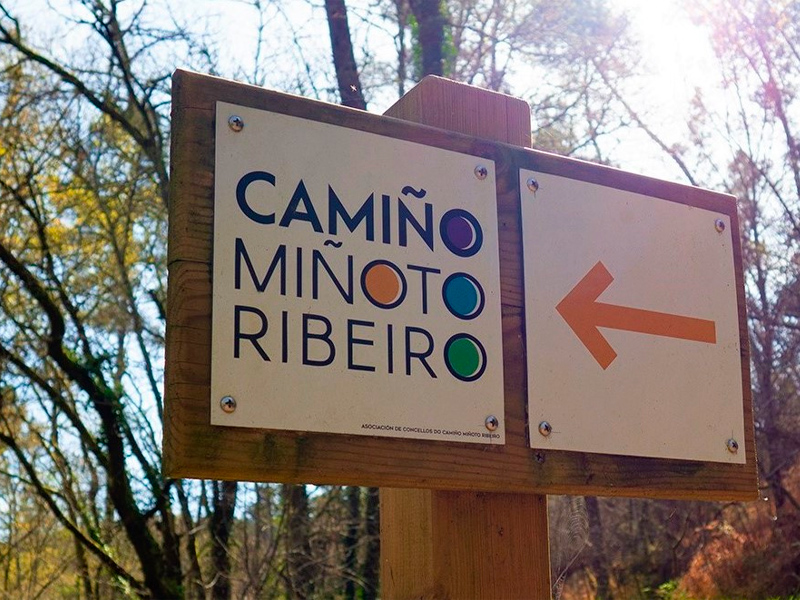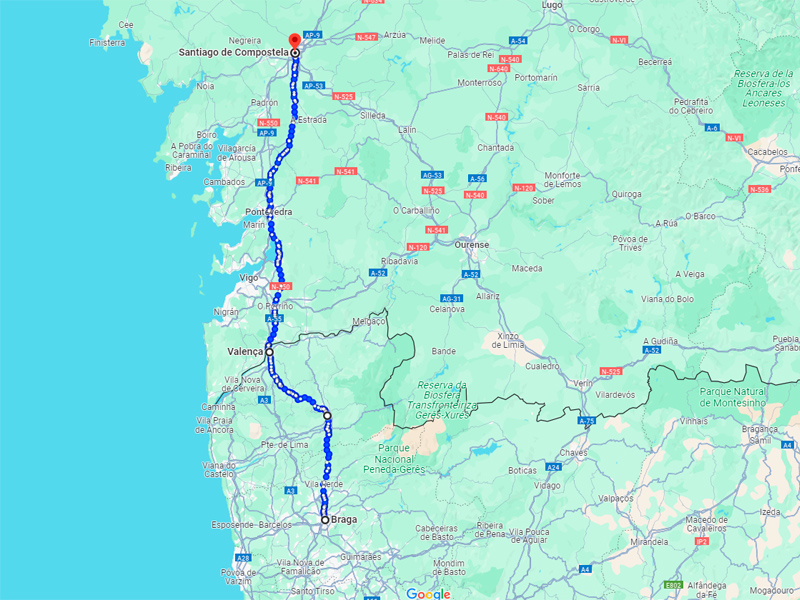The Santiago Ways, a network of routes converging at the sanctuary of Santiago de Compostela in Galicia, Spain, represent a unique pilgrimage for thousands of people. With a history dating back to the 9th century, these trails have drawn pilgrims from all parts of the world, seeking not only the physical destination but also spiritual, cultural, and personal fulfillment.
Even for those who don’t embark on the Santiago trails with religious motivations, the experience offered by these routes transcends any border, proving to be a unique journey for hiking enthusiasts as well. More than just a walking route, the Santiago Ways provide an excellent opportunity to get lost in nature, absorb local culture, and witness the beauty of the surrounding environment.
Today, we highlight the picturesque Minhoto Ribeiro Path, one of the oldest routes connecting northern Portugal to the apostle Santiago’s city. In particular, this trail stands out for its serenity, the picturesque villages it passes through, and breathtaking landscapes. Keep reading to learn everything about this trail and discover your next adventure!
The Minhoto Ribeiro Path
Starting in Braga, the Minhoto Ribeiro Path is one of the most important routes on the pilgrimage routes to Santiago de Compostela. Spanning over 240 kilometers, this trail crosses Portuguese and Spanish municipalities, introducing you to some of the most emblematic cities of both countries.
Marked by centuries of history and culture, the Minhoto Ribeiro Path begins in the city of Braga. Leaving behind the urban hustle, it enters into countryside landscapes that paint picturesque villages. Ponte da Barca welcomes walkers with its medieval bridge and the serenity of the Lima River banks. The second phase takes pilgrims through trails that wind through the heart of Minho. The atmosphere is unique, and in the distance, Valença appears with its imposing walls and cobblestone streets.
As you cross the border, the landscape gently changes, but the magical ambiance remains. Redondela, on the banks of the Vigo Estuary, offers a well-deserved rest to pilgrims, with its parks and captivating views. The fourth stage is marked by the coastal beauty and the salty aroma of the ocean. Upon reaching Pontevedra, tranquility takes over. The final phase leads pilgrims through forests and fields which, nearing the end, give way to the imposing symbol of the journey: the Cathedral of Santiago.
Each village and city along the Minhoto Ribeiro Path is a time capsule, offering pilgrims not only a physical challenge but also an immersion in traditions, flavors, and sounds that have shaped the unique heritage of Minho and Galicia. Thus, this trail is more than a geographical route; it is a journey through history where each step is a discovery – and a living link between the past and the present of these enchanting regions.

How to prepare for the pilgrimage?
Before setting foot on the trail, it is crucial to make some preparations to ensure a smooth and safe pilgrimage. From suitable equipment to timely physical preparation, here are some tips to enhance your experience:
- Opt for sturdy and comfortable footwear already adapted to your feet. Consider bringing sandals for resting times;
- Carry a lightweight yet spacious backpack to carry essential items;
- Choose lightweight, breathable clothes adaptable to weather conditions;
- Be prepared for sudden weather changes. A raincoat and waterproof clothing will ensure comfort in all conditions.
- Carry a first aid kit;
- Opt for compact versions of your hygiene products;
- Have physical and digital copies of your personal documents;
- Carry a GPS or map for guidance;
- Engage in regular physical activities to prepare for the hike, strengthening muscles, and increasing endurance;
- Maintain a positive mindset, be open to new experiences, and prepare to overcome challenges!
10-day itinerary along the Minhoto Ribeiro Path
The recommended duration to travel the Minhoto Ribeiro Path may vary depending on walking pace, stops along the way, and individual preferences. Most people traverse this path in 10 days, resulting in an average of 24 kilometers per day. For individuals well-prepared for such activities, this period can be shortened by increasing the distance per day.
Days 1 and 2: Braga to Ponte da Barca
Days 3 and 4: Ponte da Barca to Valença
Days 5 and 6: Valença to Redondela (entering Spain)
Days 7 and 8: Redondela to Pontevedra
Days 9 and 10: Pontevedra to Santiago de Compostela

Where to stay overnight?
This is a question that concerns all pilgrims wishing to travel the Minhoto Ribeiro Path. Strategically located along this enchanting route, Quinta da Lamosa offers more than just accommodation. It is a unique refuge that complements the pilgrims’ journey in the best possible way.
Located in the municipality of Arcos de Valdevez, and less than 15 km from the village of Sistelo, Quinta da Lamosa offers its guests a unique experience of immersion in nature. And we know very well that, at the end of an intense day of walking, calm and peaceful rest is just what you need!
Embraced by the typical architecture of the region and surrounded by the nature of the Peneda-Gerês Natural Park, this place provides a unique experience of connection with nature and well-deserved rest. Therefore, each morning that rises at Quinta da Lamosa is a burst of motivation and strength for another stage of the hike.
The lodging options at Quinta da Lamosa are truly special. From the authentic ‘Casas Espigueiro,’ allowing guests to delve into Minho’s history, to the charming Treehouse, built in harmony with the surrounding nature, all accommodations promise comfort and authenticity. Equipped with Wi-Fi, TV, air conditioning, and heating, each house ensures a comfortable and welcoming stay at any time of the year.
Reservations at Quinta da Lamosa can be made through Quinta Lamosa Booking, facilitating the planning of your itinerary in a convenient way. Prepare yourself to embark on the 240 kilometers to Santiago de Compostela and embrace the essence of Minho at Quinta da Lamosa.
Are you ready for the challenge? Happy pilgrimage!


